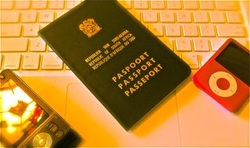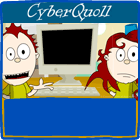What is Digital Citizenship?

It is a concept that helps teachers and parents to understand what skills children should know in the appropriate use of technology. Most often, these skills are taught long after children get their hands on digital devices, so the sooner we teach them how to use technology responsibly, the better.
What keeps children safe when using mobile technology is not so much learning to follow a set of adult prescribed rules, but empowering them to protect themselves by teaching critical thinking, digital literacy and digital etiquette.
These are the 9 elements, with the first 5 being most relevant to mobile technologies such as iPods, iPod Touches and iPads:
1. Digital Etiquette: electronic standards of conduct or procedure.
2. Digital Communication: electronic exchange of information.
3. Digital Literacy: process of teaching and learning about technology and the use of technology.
4. Digital Access: full electronic participation in society.
5. Digital Rights & Responsibilities: those freedoms extended to everyone in a digital world.
6. Digital Law: electronic responsibility for actions and deeds
7. Digital Commerce: electronic buying and selling of goods.
8. Digital Health & Wellness: physical and psychological well being in a digital technology world.
9. Digital Security: electronic precautions to guarantee safety.
Copyright 2007-2009. Mike Ribble. All rights reserved.
http://digitalcitizenship.net/Nine_Elements.html
What keeps children safe when using mobile technology is not so much learning to follow a set of adult prescribed rules, but empowering them to protect themselves by teaching critical thinking, digital literacy and digital etiquette.
These are the 9 elements, with the first 5 being most relevant to mobile technologies such as iPods, iPod Touches and iPads:
1. Digital Etiquette: electronic standards of conduct or procedure.
2. Digital Communication: electronic exchange of information.
3. Digital Literacy: process of teaching and learning about technology and the use of technology.
4. Digital Access: full electronic participation in society.
5. Digital Rights & Responsibilities: those freedoms extended to everyone in a digital world.
6. Digital Law: electronic responsibility for actions and deeds
7. Digital Commerce: electronic buying and selling of goods.
8. Digital Health & Wellness: physical and psychological well being in a digital technology world.
9. Digital Security: electronic precautions to guarantee safety.
Copyright 2007-2009. Mike Ribble. All rights reserved.
http://digitalcitizenship.net/Nine_Elements.html
Striving for a safer cyberworld for our children
The Family Online Safety Institute (FOSI) works to make the online world
safer for kids and their families. They do this by identifying and
promoting best practices, tools and methods in the field of online
safety that also respect free expression.
| |||||||||||||||||||||||||||
|
Why is it so important to teach young children responsible mobile technology use?
Watch the video below, created by FOSI, which highlights some alarming statistics. Unless we, as educators teach our children at an early age the importance of responsible digital citizenship, then they too will be one of these statistics.
Useful resources
Cybersmart
Cybersmart is a national cybersafety educational program managed by the Australian Communications and Media Authority (ACMA), Here you will find resources and practical advice to help pre-school children, primary school children, teens and parents safely enjoy the online world.
Digital Citizenship
An online program developed by the NSW Department of Education and Training, designed to support the implementation of a Digital Citizenship program.
Connect.ed
An innovative, self-paced cybersafety education program for teachers, called Connect.ed which has been developed by ACMA
Digital Citizenship Pledge/Acceptable use of technology agreements
Creating a Digital Citizenship pledge for children in the classroom can be a useful tool in ensuring they understand what is expected of them in the classroom.
Drawing up Acceptable use of technology agreements for both students and parents to sign is a good way to clearly outline the expectations in your educational setting.
Below are some examples of school "Acceptable use of technology" agreements
| aupst_lukes-1.doc |
| acceptable_use_agreement_prep_-_yr_2-2.docx |
| acceptable_use_agreement_st_caths_3-7.docx |
Games and videos
Upper Primary to Lower Secondary

"Digizen", CyberNetrix present children with scenarios in cybersafety.

MOBILISed is licensed under a Creative Commons Attribution-NonCommercial-ShareAlike 3.0 Unported License.



